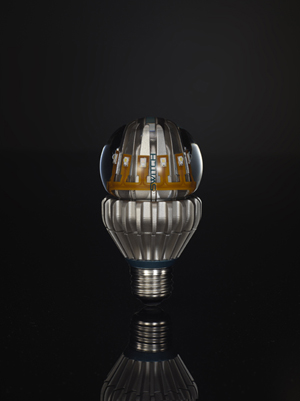 This September, Switch Lightbulbs will launch its twenty-first-century version of the ubiquitous incandescent bulb, which is slated to be phased out in the United States starting in 2012, according to the Energy Independence and Security Act authorized in Congress in 2007. The Switch LED bulb looks similar to the classic screw-in, but features some significant differences. Moreover, the bulb’s components are designed to be completely recycled and reused and to never end up in a landfill – unlike their nineteenth-century predecessors.
This September, Switch Lightbulbs will launch its twenty-first-century version of the ubiquitous incandescent bulb, which is slated to be phased out in the United States starting in 2012, according to the Energy Independence and Security Act authorized in Congress in 2007. The Switch LED bulb looks similar to the classic screw-in, but features some significant differences. Moreover, the bulb’s components are designed to be completely recycled and reused and to never end up in a landfill – unlike their nineteenth-century predecessors.
While LED lamps have been on the market for years, they typically don’t have a lot of aesthetic appeal, and the light they emit can be cold and off-putting. I asked Brett Sharenow, Chief Strategy Officer and CFO of Switch, what makes its LED bulb different.
JG: How were you able to tackle a design problem that others have been unable to solve? Was it a question of trying to make a beautiful LED lamp because there were none on the market?
BS: Actually, we were trying to solve a cooling problem! LEDs are semiconductor chips, and they get hot when powered on. The problem is how to allow the lightbulb to operate just like an incandescent bulb – face up, down, and sideways in a socket – while cooling the LEDs uniformly. People don’t normally think about how a regular incandescent bulb is mounted/oriented, because cooling (and therefore the bulb’s lifetime) is about the same regardless of orientation. However, with LEDs, most manufacturers have not figured out how to provide uniform cooling, and thus uniform lifetime, regardless of orientation.
We took this on as a challenge, because we wanted a “direct replacement” for an incandescent bulb, knowing that consumers normally just screw a lightbulb into a socket without worrying about orientation. In order to accomplish this, we developed a liquid-cooling solution, mounting the LEDs at about the midline of the glass sphere. This, along with some other design efforts, helped ensure that our bulb would operate consistently regardless of orientation. Following the initial work, we worked on the bulb design, using both clear and frosted glass to provide a beautiful aesthetic that provides a “wow” factor.
JG: Why this problem and not another?
BS: Cooling the LEDs and the driver — the component that converts 120V AC house power to the DC voltage needed to power the LEDs — is the key in all LED lightbulbs. Ensuring full light output and long life from the LEDs requires cooling them so that we don’t exceed the manufacturer’s requirements for maximum temperature. We looked into many ways of cooling the LEDs and found that liquid-cooling was the most effective cost-wise, thermally, and from a reliability perspective.